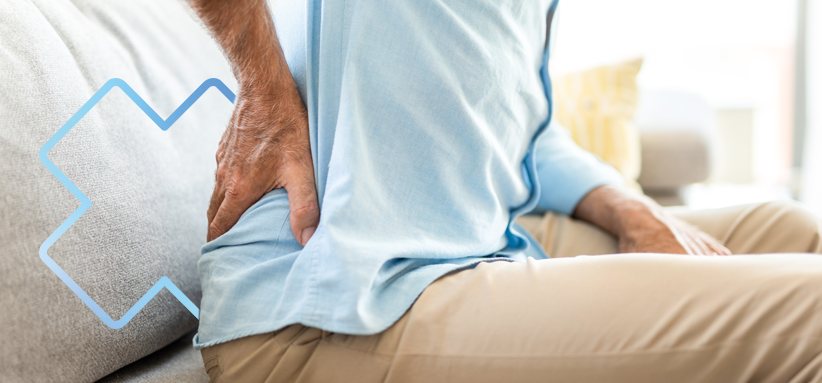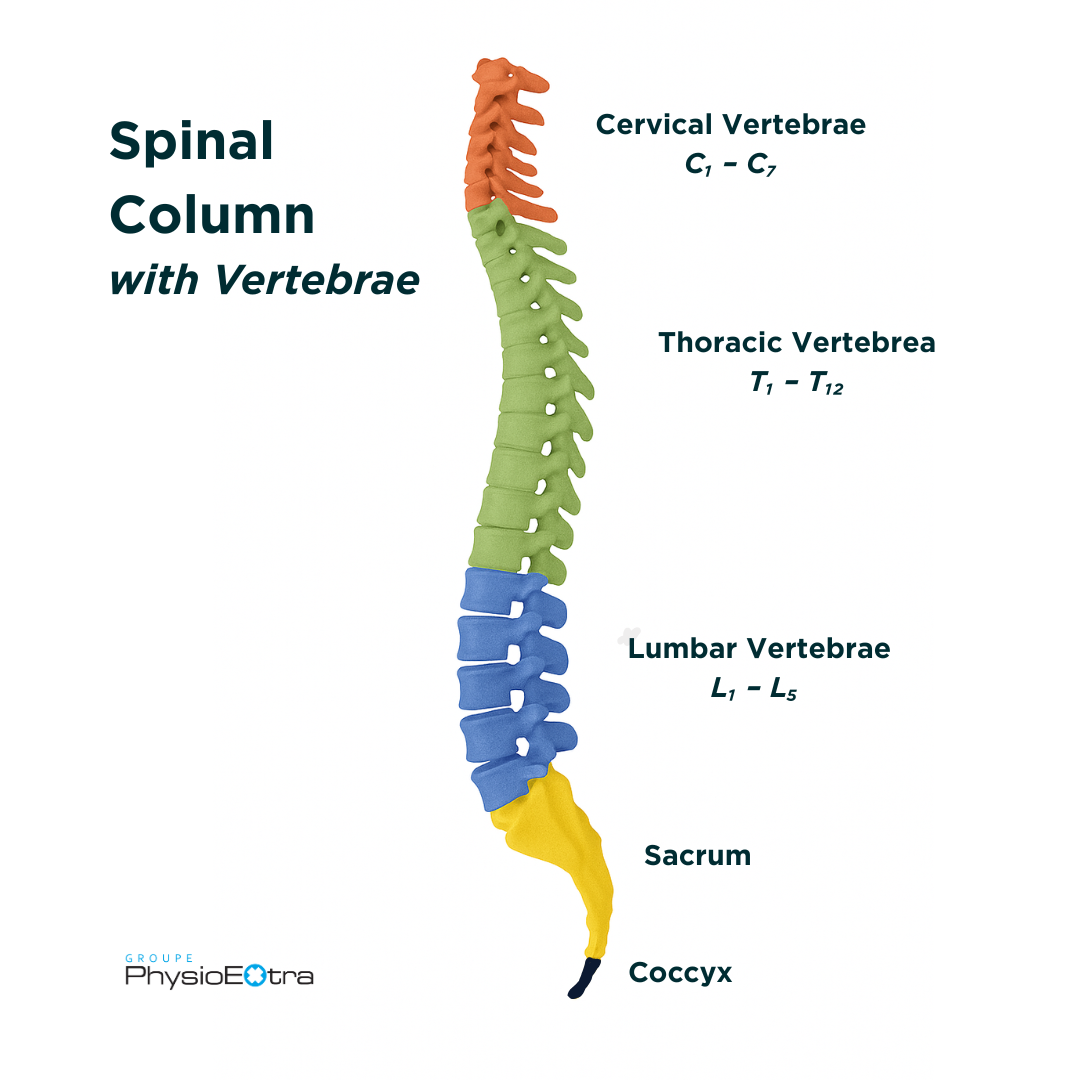Lower back pain, or lumbago (the medical term for pain in the lower back), is a very common musculoskeletal condition. While most cases improve within a few weeks, many people experience recurrences. Discover the causes, symptoms, and best treatments to relieve and prevent lower back pain.

What is lumbago?
Lumbago is defined as pain localized in the lower back. It can be acute (less than 6 weeks), subacute (6 to 12 weeks), or chronic (more than 3 months).
Common symptoms:
- Localized pain
- Stiffness
- Numbness
- Loss of mobility
- Pain radiating down the leg (sciatica)
The lumbar anatomy includes 5 vertebrae separated by intervertebral discs (see image below). These structures, along with muscles, nerves, and ligaments can become sources of pain in cases of injury, inflammation, or degeneration.

Lumbago causes and conditions
The causes of lower back pain are often multifactorial: poor posture, repetitive strain, sudden movements, physically demanding work, or prolonged inactivity.
A wide range of conditions can affect the lumbar region. The lower back is prone to both traumatic and degenerative injuries, which may sometimes lead to leg pain. The most common include:
- Herniated disc: displacement of the disc’s nucleus that can irritate a nerve.
- Lumbosciatica: pain radiating into the leg due to irritation of the sciatic nerve.
- Facet joint irritation: localized pain in the lumbar joints.
- Spinal/foraminal stenosis or spondylolisthesis.
- Degenerative conditions: such as disc degeneration.
Persistent pain differs from acute pain: treatment must be tailored accordingly.
Frequently Asked Questions (FAQ)
Should I stop moving if I have lower back pain?
No. Movement is essential for recovery, within your tolerance. Only very sharp or intense pain may justify a short period of rest.
Can electrotherapy help with lower back pain?
Scientific studies do not appear to support the use of electrotherapy (e.g., ultrasound) for cases of lower back pain except in certain situations where the pain is very intense. Instead, scientific evidence favors patient activation combined with manual therapy as more effective approaches to managing and relieving low back pain.
Can ice or heat relieve pain?
Ice and heat applied for 15–20 minutes can provide temporary relief from pain.
Is an MRI necessary to diagnose lower back pain?
Not necessarily. Most cases of lower back pain are effectively treated without imaging. An MRI may be useful if severe symptoms persist after 6 weeks of treatment.
Is surgery often required?
No. It is reserved for severe or persistent cases. Physiotherapy remains the treatment of choice in the majority of cases.
When should you be concerned about lower back pain?
Back pain can be concerning when it occurs with red flag symptoms such as urinary or fecal incontinence, numbness or weakness in both legs, or loss of sensation in the genital area. Pain accompanied by night sweats, fever, or following trauma, especially in older adults, may also indicate a more serious condition.
How can I tell if my back pain is coming from my kidneys?
In everyday language, it’s not uncommon to hear someone with back pain say they’ve “thrown out their back.” In reality, it’s rare that this pain has anything to do with the kidneys. Mechanical pain originating from the lumbar region varies with movement. The person may feel stiffness after staying in the same position for a while, and muscle spasms are often visible. Kidney infections (pyelonephritis) may be accompanied by fever and a burning sensation when urinating. Movement typically has no effect on the intensity of kidney-related pain.
Low back pain in women vs. men
Mechanical low back conditions are generally similar in both women and men. However, during pregnancy and breastfeeding, the presence of the baby along with hormonal changes can lead to pain in women, particularly in the sacroiliac joint, and may predispose them to sciatica.
Lower back pain on the left or right: what does it mean?
Depending on the affected structure, lower back pain can sometimes be central, appearing as a band across the back, or localized unilaterally to the right or left of the spine. The pain may also shift depending on the movement performed or the time of day. By assessing you, the physiotherapist will be able to explain more precisely what is causing your back pain.
How to relieve lower back pain?
Expert tip : Stay active !
Even when in pain, adapted physical activity supports recovery, depending on your tolerance. Avoid prolonged bed rest. As soon as possible, change positions or take gentle walks within your limits. Returning to work quickly, even on a modified basis, increases the chances of full recovery.
Which professional should you see?
Different professionals often work together to maximize results. When in doubt, we recommend consulting a physiotherapist first, so they can assess your needs and recommend the appropriate treatments for your specific back condition. If necessary, they will refer you to the right professional(s) to optimize your rehabilitation.
Why consult a physiotherapist?
The physiotherapist will conduct a detailed assessment, covering both your pain history and physical condition. Through this evaluation, they can identify the main problem areas, such as joint mobility loss, nerve mobility restrictions, muscle tension, muscle weakness, and more. This helps guide the treatment plan appropriately.
Next, they may give you specific home exercises as well as recommendations tailored to your condition (for example, what you can do and what you should avoid).
Finally, the physiotherapist may use various treatment techniques to support your recovery. These may include manual therapy techniques to restore mobility in affected joints and nerves or to release muscle tension.
Why consult an occupational therapist?
The occupational therapist will assess how your back condition affects your usual activities such as work, household tasks, and leisure. Their interventions which may include strengthening exercises or simulated work tasks, for example will help you maximize your independence at every stage of your recovery.
Why consult an osteopath?
Using various manual techniques, the osteopath will treat mobility restrictions that may affect all the structures of your body (bones, muscles, ligaments, internal organs, etc.) related to your back. Improved mobility allows the body to recover more effectively and reduces pain.
Why consult a massage therapist?
The massage therapist mainly works to release tension in both the superficial and deep tissues affecting your back, helping to reduce pain and improve your freedom of movement. Their treatments also help increase blood circulation to support better recovery.
Why consult an acupuncturist?
Using various techniques and therapeutic tools such as needles and suction cups, the acupuncturist works to reduce pain, stress, muscle tension, and inflammation that may occur following a back injury.
Why consult a kinesiologist?
The kinesiologist will teach you adapted exercises, based on their evaluation of your back’s movement capacity and your physical condition, to help you return to your activities.
Have questions? Call us at 1 855 743-9872 or write to us at informationsweb@physioextra.ca. Our team will guide you to the right professional.


